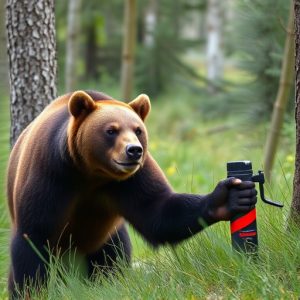Mastering Bear Safety: When and How to Use Repellent Spray
Bears, especially black and grizzly bears, increasingly enter human camping territories, emphasizing…….
Bears, especially black and grizzly bears, increasingly enter human camping territories, emphasizing the need for campers to understand bear behavior and anticipate encounters. Spring and summer, when bears actively seek food for their cubs, see peak bear activity. Evaluating local risk factors, understanding specific bear species' behavior, and choosing the right bear repellent spray (considering type, effectiveness, and safety aspects) are crucial for safe camping in known bear habitats. Proper usage techniques, including distance, angle, multiple applications, and aiming carefully for 3-4 seconds, ensure effective protection. Combining bear spray with secure food storage, noise-making while hiking, and understanding local bear behavior enhances overall safety in bear country.
“Enhancing your camping experience in bear country? Bear repellent spray is an essential tool that can transform a potential encounter into a safe, memorable adventure. This guide navigates the world of bear behavior, risk assessment, and the art of choosing the right bear spray. From understanding when to use bear spray properly to mastering application techniques, you’ll learn to complement these measures with additional prevention strategies for a secure camping experience in bear-inhabited areas.”
- Understanding Bear Behavior: When and Where to Expect Encounters
- Assessing Your Risk: Factors Influencing Bear Activity Near Campsites
- Choosing the Right Bear Repellent Spray: Types, Effectiveness, and Safety Considerations
- Correct Usage Techniques: Ensuring Maximum Efficacy During Emergencies
- Additional Prevention Measures: Complementary Strategies for Safe Camping in Bear Country
Understanding Bear Behavior: When and Where to Expect Encounters
Bears, both black and grizzly, are increasingly venturing into human territories, especially in camping areas. Understanding their behavior is crucial for campers to anticipate potential encounters and use bear repellent spray effectively. These intelligent animals have a keen sense of smell, and they often associate food or potential threats with certain scents. When campgrounds have a history of bear activity, it’s essential to be prepared.
Bear encounters are most common during the spring and summer months when bears are actively seeking food for their cubs. Camping in areas known for bear habitats, especially near forests, rivers, or alpine regions, requires heightened awareness. While they may seem curious, bears can quickly turn aggressive if they perceive a threat or associate humans with food. Knowing when to use bear spray properly involves recognizing these cues and being proactive in deterring potential attacks.
Assessing Your Risk: Factors Influencing Bear Activity Near Campsites
When deciding whether bear repellent spray is an essential part of your camping gear, assessing the local risk factors is crucial. Bear activity near campsites can vary greatly depending on several variables. One key factor is the abundance and type of food sources available in the area. Bears are attracted to campgrounds where food scraps or potential meals are easily accessible, such as trash cans not properly secured or areas with high berry concentrations. Additionally, the time of year plays a significant role; mothers with cubs are more active during spring and summer, increasing the likelihood of encounters.
Understanding the specific bear species in your region is essential for proper usage of bear spray. Different bears have varying behaviors and dietary preferences. For instance, black bears often seek out food in campsites while grizzly bears tend to avoid human interactions unless provoked or protecting their young. Knowing these patterns helps campers determine when and where bear spray might be most effective as a deterrent.
Choosing the Right Bear Repellent Spray: Types, Effectiveness, and Safety Considerations
When choosing a bear repellent spray, it’s essential to consider its types, effectiveness, and safety aspects. The market offers two main categories: air-dispensed and aerosol sprays. Air-dispensed options emit a stream of spray that can cover a wider area, making them ideal for fast reactions during encounters. Aerosol sprays, on the other hand, provide a direct, focused blast that can deter bears from close distances.
Effectiveness varies between brands, with some formulas containing capsaicin, a component derived from chili peppers, known for its irritant properties to bears’ eyes and respiratory system. Testing is crucial; ensure the spray meets industry standards and has proven effectiveness in repelling bears. Safety considerations include proper handling, storage, and usage instructions. Always follow guidelines regarding distance, angle, and multiple applications for optimal results during encounters, specifically when food storage is involved or in areas known for bear activity.
Correct Usage Techniques: Ensuring Maximum Efficacy During Emergencies
When to Use Bear Spray Properly, involves understanding correct usage techniques for maximum efficacy. Firstly, always carry it in an easily accessible location, like a belt pouch or backpack, so you can grab it quickly during an encounter. Secondly, ensure proper ventilation before spraying; open windows or doors to prevent the spray from settling back onto you. Thirdly, maintain eye contact with the bear and aim for the face, nose, and eyes—these areas are sensitive, and targeting them can deter an attack more effectively. Finally, use a quick, short burst of spray rather than a prolonged stream, as it’s more likely to startle the bear without aggravating it further.
During emergencies, correct usage techniques become even more critical. If you’re confronted by a bear, stay calm and assess the situation. Back away slowly if the bear hasn’t noticed you, but make loud noises to communicate your presence if it has. If a defensive posture or noise doesn’t deter the bear, deploy the spray. Aim carefully, remember to breathe, and spray for about 3-4 seconds. Then, retreat immediately to a safe distance and watch for any signs of aggression before proceeding further.
Additional Prevention Measures: Complementary Strategies for Safe Camping in Bear Country
When venturing into bear country, it’s crucial to understand that no single method guarantees complete protection. While bear repellent spray is an essential tool for camping in areas known for bear activity, it should be used in conjunction with other preventive measures. Proper food storage is paramount; secure your supplies in bear-resistant containers or hang them out of reach in a sturdy tree. Avoiding unexpected encounters involves making noise while hiking to signal your presence and keeping a clean camp by properly disposing of food scraps.
Additionally, knowing local bear behavior and regulations can significantly enhance safety. Researching the types of bears in the area and their habits allows campers to prepare accordingly. Following guidelines for interacting with bears, such as not approaching or running, can prevent aggressive reactions. When to use bear spray properly is a skill worth mastering; practice makes perfect, ensuring you’re prepared should a grizzly cross your path.
When camping in bear country, understanding bear behavior and knowing when to use bear spray properly is essential. By assessing your risk factors and choosing the right repellent, you can significantly enhance your safety. Remember, prevention is key; combine the right gear with smart practices like food storage and noise awareness to reduce potential encounters. With the right knowledge and tools, enjoying the outdoors becomes a more secure experience. Always stay alert and prepared when navigating these wild environments.

